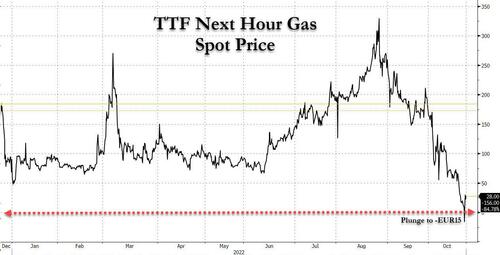
Last week we pointed out a bizarre development off the coast of the energy starved European continent: some 35 LNG carriers were idling off the coast of Spain (the country which has six LNG import and regasification terminals and is the biggest LNG importer in the EU).
As Reuters put it, the tanker pileup highlighted Europe’s problem with LNG import capacity that prompted Germany to urgently strike a deal for the construction of two floating facilities so it can receive LNG directly: the region has had to find alternative supplies, including LNG, but the arrival of multiple cargoes of the superchilled fuel has exposed Europe’s lack of “regasification” capacity, as plants that convert the seaborne fuel back to gas are operating at maximum limit.
If the backlog is not cleared soon those ships may start looking for alternative ports outside Europe to offload their cargo.
Meanwhile, there is more LNG floating off the European coast, Reuters reported, citing more sources, suggesting the 35-strong tanker crowd off Spain is only part of the actual pile-up.
“Floating storage levels in LNG shipping is at all time high levels with slightly more than 2.5 million tonnes tied up in floating storage,” Flex LNG Management chief executive Oystein Kalleklev told Reuters.
Add to the epic pileup of LNG tankers the fact that most of Europe’s storage facilities are almost full ahead of the winter (As of Sunday, EU storage facilities were 93.4% full, with the continent’s two biggest markets, Germany and Italy, recording even higher levels), and couple that with weather forecasts suggesting that temperatures in continental Europe will be between 4 and 8 degrees Celsius warmer than the seasonal average this week, implying lower demand, and the result was a sharp drop in European nat gas futures.
At one point in the morning, front-month Dutch TTF futures, which serve as a benchmark for northwest Europe, were down over 10% at 101.39 euros a megawatt-hour, having opened at a new four-month low of 100 EUR/MWh.
But what is more remarkable is that the lack of storage availability – similar to what happened in April 2020 when WTI briefly traded as far negative as -$40 – has forced ultra-short term spot prices to collapse as those assigned delivery (without a place to store the gas) were literally paying others to take the gas off their hands!
And sure enough, early on Monday, the “next hour” TTF contract briefly dipped as far negative as -EUR15.78, the lowest on record as there was simply nowhere to park the nat gas.
Still, just like the negative WTI print in April 2020 was an historic outlier, so don’t expect today’s negative “next hour” gas print to become a frequent occurrence, especially since the more conventional (one month, etc) European winter prices remain very high amid continued uncertainty over the fate of European gas, because while the winter of 2022 may avoid the worst case scenario (which again will depend on just how cold the coming winter will be), it is the winter of 2023 where all bets are off.
